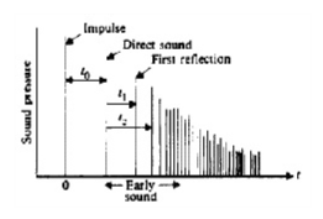 When sound is emitted from a loudspeaker or group of loudspeakers, only a very small percentage (<10%) actually arrives as direct sound to the listening position. The remaining 90 + % is considered off axis or non direct energy and is greatly affected by the listening environment or room itself. We first hear the sound via the direct path from the source (Direct Sound). Shortly thereafter, the listener will experience the attenuated reflections off the floor,walls and ceiling (First Reflections). These First Reflections will again be further delayed and attenuated as the sound is reflected repeatedly off all of the room's surfaces. This results in the total reverberation of the sound.
When sound is emitted from a loudspeaker or group of loudspeakers, only a very small percentage (<10%) actually arrives as direct sound to the listening position. The remaining 90 + % is considered off axis or non direct energy and is greatly affected by the listening environment or room itself. We first hear the sound via the direct path from the source (Direct Sound). Shortly thereafter, the listener will experience the attenuated reflections off the floor,walls and ceiling (First Reflections). These First Reflections will again be further delayed and attenuated as the sound is reflected repeatedly off all of the room's surfaces. This results in the total reverberation of the sound.
 The ETC response of a room (above) yields the observation that, in good rooms, sound decays at an exponential rate which can be mathematically predicted via the following relation:. RT= .161*V/A. Where V= room volume and A= absorption of room items. Simply stated bigger rooms take longer to quiet down and look different from a graphic perspective. Furnishings (A) within the room absorb reflected energy. Draperies or sound absorbing materials increase the "quiet" rate. What your room is made of also makes a difference. The very best rooms have just the right balance of absorption and reflection. Below are commonly used construction materials along with their absorption coefficients. As an example, concrete block (unpainted) absorbs nearly 36% of sound energy at around 125 Hz., while draperies do better at high frequencies (35% at 4000 Hz) but have poor absorption at lower frequencies. Carpet with pad has high absorption at approx.4000 Hz but very little at 125 Hz. Window glass has good absorption at low frequencies but is very reflective at higher frequencies.
The ETC response of a room (above) yields the observation that, in good rooms, sound decays at an exponential rate which can be mathematically predicted via the following relation:. RT= .161*V/A. Where V= room volume and A= absorption of room items. Simply stated bigger rooms take longer to quiet down and look different from a graphic perspective. Furnishings (A) within the room absorb reflected energy. Draperies or sound absorbing materials increase the "quiet" rate. What your room is made of also makes a difference. The very best rooms have just the right balance of absorption and reflection. Below are commonly used construction materials along with their absorption coefficients. As an example, concrete block (unpainted) absorbs nearly 36% of sound energy at around 125 Hz., while draperies do better at high frequencies (35% at 4000 Hz) but have poor absorption at lower frequencies. Carpet with pad has high absorption at approx.4000 Hz but very little at 125 Hz. Window glass has good absorption at low frequencies but is very reflective at higher frequencies.
Frequency (Hz)
Material  125 250 500 1000 2000 4000
125 250 500 1000 2000 4000
Concrete block, unpainted  0.36 0.44 0.31 0.29 0.39 0.25
0.36 0.44 0.31 0.29 0.39 0.25
Concrete block, painted  0.10 0.05 0.06 0.07 0.09 0.08
0.10 0.05 0.06 0.07 0.09 0.08
Glass, window  0.35 0.25 0.18 0.12 0.07 0.04
0.35 0.25 0.18 0.12 0.07 0.04
Plaster on lath 0.14 0.10 0.06 0.05 0.04 0.03
Plywood paneling 0.28 0.22 0.17 0.09 0.10 0.11
Carpet on pad 0.08 0.24 0.57 0.69 0.71 0.73
Gypsum board, one-half inch 0.29 0.10 0.05 0.04 0.07 0.09
Drapery, lightweight 0.03 0.04 0.11 0.17 0.24 0.35
 So what does all of this mean? Your room is a complex reflector and absorber and will "sound"a certain way based upon how it is was constructed and what you have in it. Waterfall plots below show an average sized room. Untreated (top graph below), shows highs and upper mids(rt side) are dispersing nicely while lower mid and upper bass(left side) are slow to quiet down. As a result, male voices may be lacking in definition and sound thick while violins are clean and natural. Though slight, this imbalance will significantly reduce overall enjoyment.
So what does all of this mean? Your room is a complex reflector and absorber and will "sound"a certain way based upon how it is was constructed and what you have in it. Waterfall plots below show an average sized room. Untreated (top graph below), shows highs and upper mids(rt side) are dispersing nicely while lower mid and upper bass(left side) are slow to quiet down. As a result, male voices may be lacking in definition and sound thick while violins are clean and natural. Though slight, this imbalance will significantly reduce overall enjoyment.

 Mathematical algorithms can predict certain behavior based upon dimensions and furnishings. Computer programs can aid in the set up and positioning of speaker systems. But in the end it comes down to the determination of the listener to experiment with different wall treatments, speaker and seating positions. Far too often we come into contact with theaters and listening rooms that suffer greatly from excess reflections and poorly treated side and rear walls. This is why it is important to measure, "tweak" and LISTEN . Your Source dealer, trained in optimizing room acoustics, can make significant improvements that will greatly increase overall performance.
Mathematical algorithms can predict certain behavior based upon dimensions and furnishings. Computer programs can aid in the set up and positioning of speaker systems. But in the end it comes down to the determination of the listener to experiment with different wall treatments, speaker and seating positions. Far too often we come into contact with theaters and listening rooms that suffer greatly from excess reflections and poorly treated side and rear walls. This is why it is important to measure, "tweak" and LISTEN . Your Source dealer, trained in optimizing room acoustics, can make significant improvements that will greatly increase overall performance.
 125 250 500 1000 2000 4000
125 250 500 1000 2000 4000 0.36 0.44 0.31 0.29 0.39 0.25
0.36 0.44 0.31 0.29 0.39 0.25 0.10 0.05 0.06 0.07 0.09 0.08
0.10 0.05 0.06 0.07 0.09 0.08 0.35 0.25 0.18 0.12 0.07 0.04
0.35 0.25 0.18 0.12 0.07 0.04
